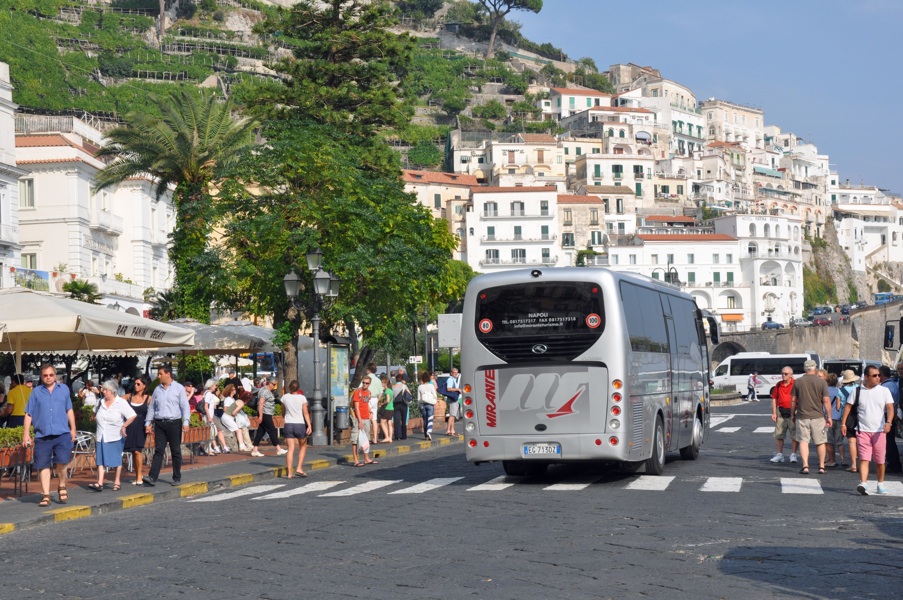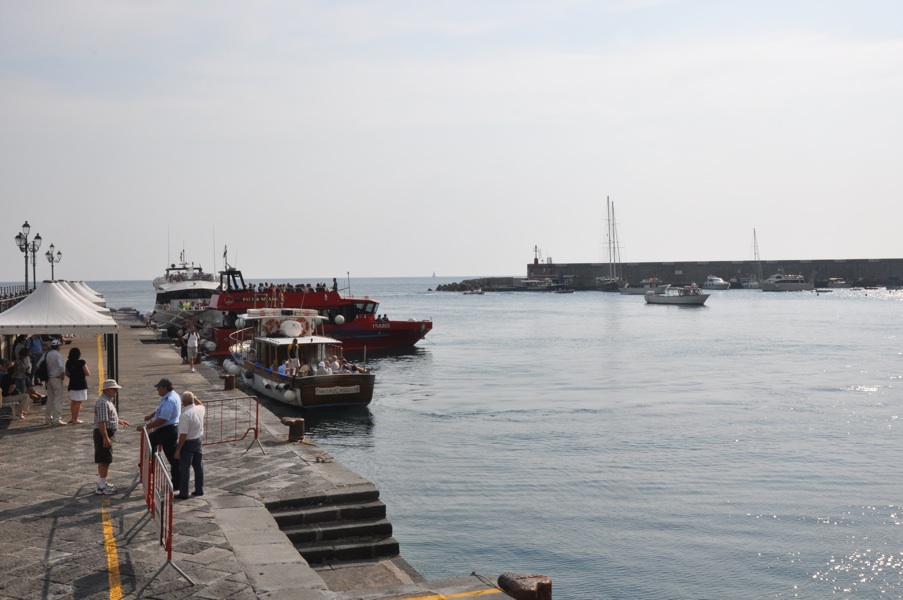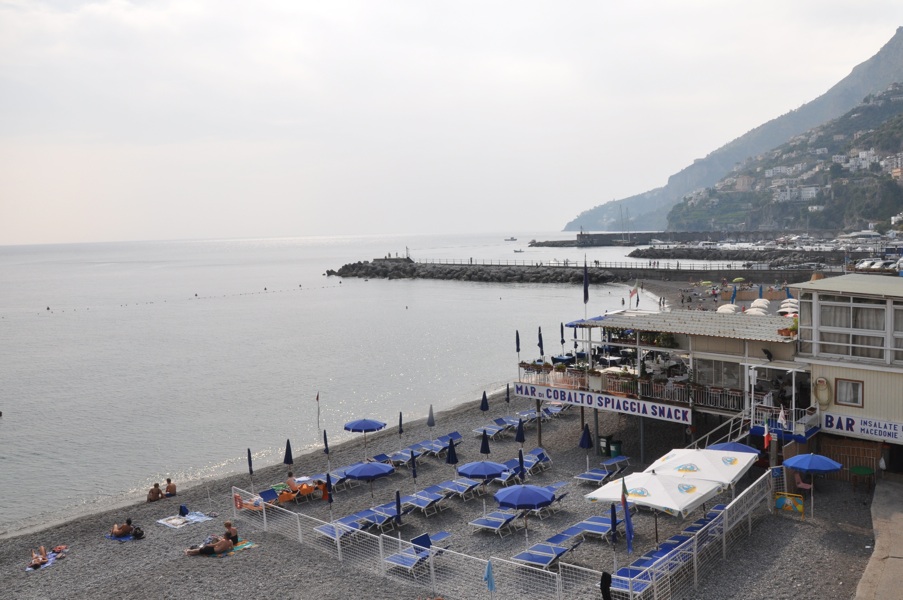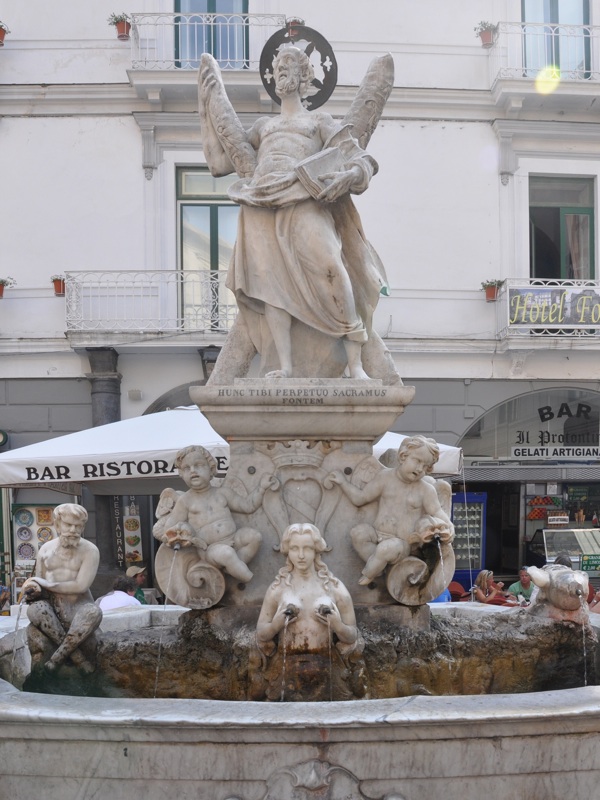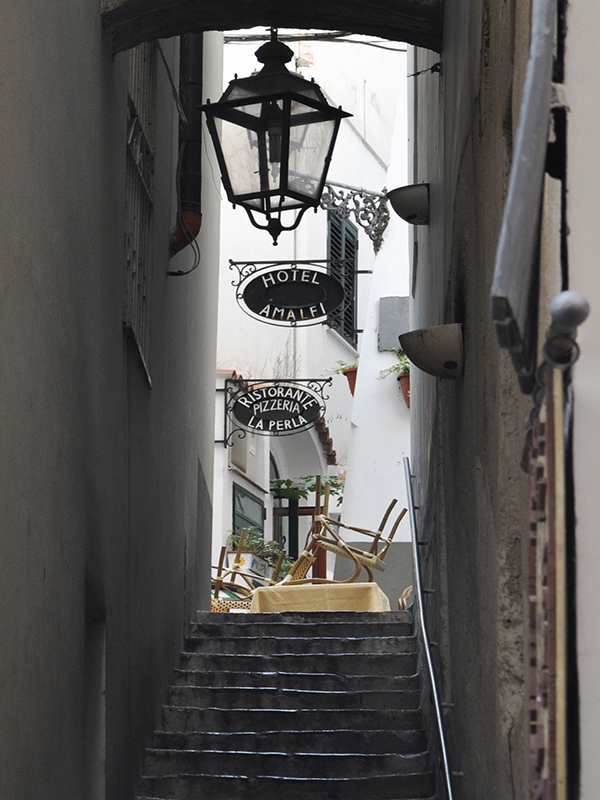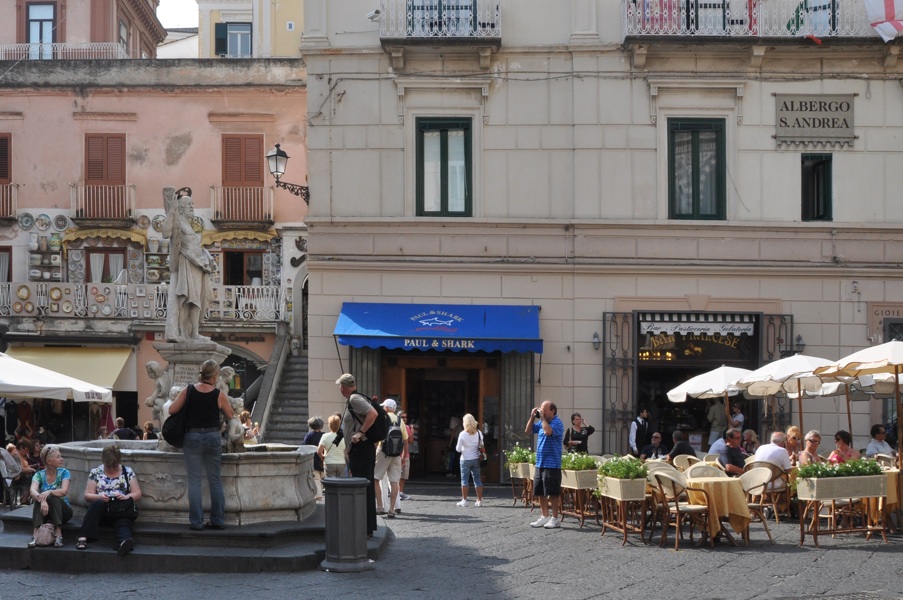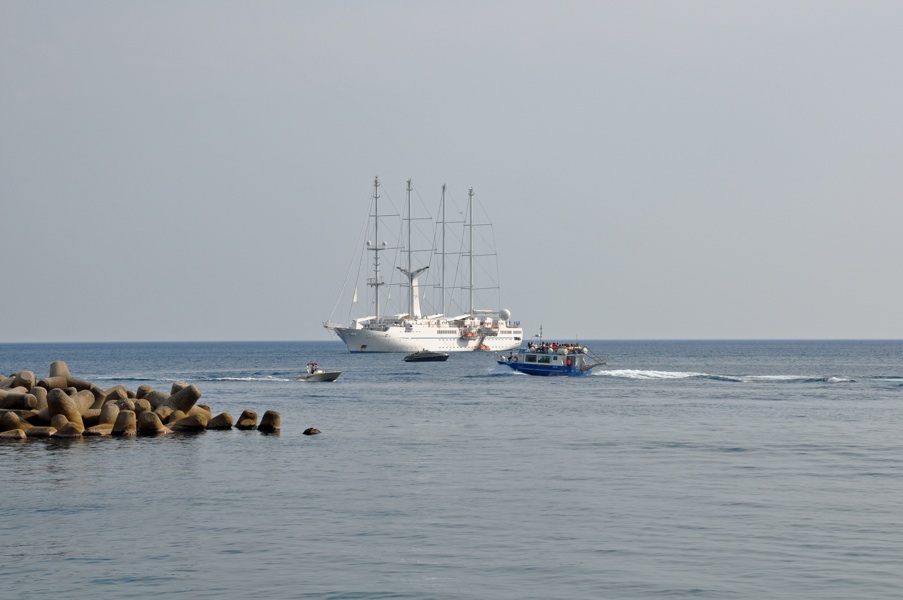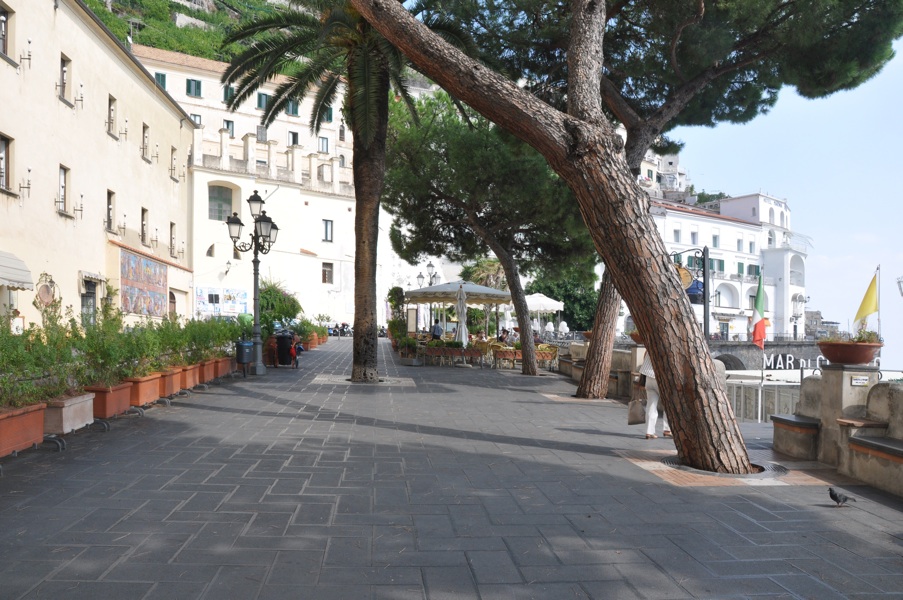Picturesquely situated tourist town and commune (over 5,000 inhabitants) in southern Italy, in the Campania region, in the province of Salerno, on the so-called Amalfi Coast, approx. 70 km southeast of Naples  , 25 km on southwest of Salerno
, 25 km on southwest of Salerno  , the provincial capital. A city with a long history, once the capital of one of Italy's four powerful maritime republics, beside Genoa, Pisa and Venice. In the 1920s, a trendy holiday destination for the British aristocracy, today one of the most popular tourist destinations in Italy. Access: the most convenient road from Naples - the A3 motorway to exit Vietri sul Mare
, the provincial capital. A city with a long history, once the capital of one of Italy's four powerful maritime republics, beside Genoa, Pisa and Venice. In the 1920s, a trendy holiday destination for the British aristocracy, today one of the most popular tourist destinations in Italy. Access: the most convenient road from Naples - the A3 motorway to exit Vietri sul Mare  and continue on the SS163; the same way (only from the opposite direction) you can go from Salerno (from where you can also take the SS18 and then the SS163). Coming from Naples, you can choose one of the two shorter roads (approx. 60 km), leaving the A3 motorway, exit Castellemare di Stabia
and continue on the SS163; the same way (only from the opposite direction) you can go from Salerno (from where you can also take the SS18 and then the SS163). Coming from Naples, you can choose one of the two shorter roads (approx. 60 km), leaving the A3 motorway, exit Castellemare di Stabia  (and continue via Furore
(and continue via Furore  ) or take exit Angri
) or take exit Angri  (followed by Ravello
(followed by Ravello  ) - however, these roads are less convenient (➤
map)(➤ map).
) - however, these roads are less convenient (➤
map)(➤ map).
AMALFI
view of the main beach (Spiaggia di Marina Grande), the port and the western part of the city with the pier stretching out into the sea from Piazza Flavio Gioia
photo: PL
The first records of Amalfi date back to the 6th century. The city, strategically located on the routes of Byzantine, Arab and Western European merchants, was already known then as an important trading center, and would soon become even one of the most powerful "maritime republics" in the Mediterranean. Amalfi merchants then obtained special privileges in the main cities of this area - Constantinople, the cities of Sicily, today's Spain, or the southern coast of the Mediterranean Sea, and for a time they were also the main suppliers of goods for the popes.
AMALFI
the main beach of the city (Spiaggia di Marina Grande)
photo: PL
Amalfi was also the place where, probably in the 11th century, the first code of commercial and maritime law was created, valid in the area of the Mediterranean Sea until the 16th century - the so-called Amalfi Tables,
Tavole Amalfitane (also known as
Tabula Amalphitana or
Tabula de Amalpha, originally
Capitula et ordinationes Curiae Maritimae nobilis civitatis Amalphe).
Initially, in the 6th century and in the following centuries, Amalfi was dependent on the Byzantine Empire. Later, the city became an independent "maritime republic" (sometimes called a "principality", but with a "prince" or "doge" elected by its authorized inhabitants), whose best years were between about the middle of 9th and about the end of 12th century - at that time, especially during the reign of Manso I, who served as "prince" ("doge") in the years 966-1004, Amalfi competed in the Mediterranean with such political, military and commercial powers as Pisa, Genoa and The Venetian Republic, and the city itself was estimated to be around 70,000 inhabitants, several times more than today.
AMALFI
view to the west of the city from the SS163 road (Via Pantaleone Comite)
photo: PL
In the 11th century, with the Norman and Pisa invasions, the fall of Amalfi began; in the first half of the 12th century, after the conquest of the region and the sack of the city by the Pisans, the history of Amalfi as an independent "maritime republic" came to end. In 1434, a tsunami caused by an earthquake, the epicenter of which was in the Tyrrhenian Sea, destroyed the port of Amalfi and part of the city (the Gulf of Naples was also damaged then); after this cataclysm, Amalfi was reduced for several centuries to a place of only local importance.
The second period of the splendor of Amalfi and the so-called The Amalfi Coast, stretching from the southern shores of the Sorrentine Peninsula to Salerno, no longer as an independent political and commercial power, but as a tourist region, began in the second half of the nineteenth century, when the first guests from Europe arrived here (some of the first were e.g. Richard Wagner and Henrik Ibsen) and when tourism infrastructure was created to meet their needs (transforming, among others, former monasteries into hotels). In the first half of the 20th century, Amalfi was, as mentioned above, particularly popular with the British upper classes; from the second half of the 20th century until today Amalfi is one of the most popular tourist destinations on the Tyrrhenian coast, visited by visitors from all over the world.
AMALFI
tourists on the pier stretching out to the sea from Piazza Flavio Gioia, on the right the eastern part of the city is visible with the bell tower of the cathedral
photo: PL
Many tourists are attracted to Amalfi by the numerous events organized here. They include, among others, religious holidays related to the figure of St. Andrew the Apostle, patron of Amalfi - Festa di Sant'Andrea - celebrated each year on June 27 (according to tradition, on June 27, 1544, the city was miraculously saved by St. Andrew from the impending pirate attack) and on November 30 (on a day that tradition believes on the day of the saint's martyrdom).
AMALFI
galeone di Amalfi della regataphoto: PL
The events organized at the turn of August and September remind us that September 1 was, in the years 839-900, the day of the appointment to the office of the ruler of Amalfi, and also the first day of the new year according to the old Byzantine calendar - hence the name
Capodanno Bizantino. However, the most attractive event for tourists are the traditional regattas held since 1955, always on the first Sunday of June (every 4 years) -
Regata delle antiche repubbliche marinare - with the participation of crews from the four former "maritime republics": Amalfi, Pisa, Genoa and Venice.
The photo shows
galeone di Amalfi della regata, an Amalfi boat taking part in the regatta. The competitions are held in a different location each year: in Genoa, in Pisa on the Arno River (the first regatta took place here), in the Venetian Lagoon, or in the waters of the Amalfi Bay (with exceptions - e.g. once a regatta was organized in Turin on the River Po, on the occasion of the centenary of Italian unification, once in Monte Carlo, to celebrate the 50th anniversary of the Prince of Monaco, once in London on the Thames, etc.), always with numerous accompanying events.
The main monument of Amalfi is considered to be the Cathedral of St. Andrew the Apostle

(La cattedrale di Sant'Andrea, Duomo di Amalfi). The marker

stands for the main square of Amalfi, Piazza Flavio Gioia (named after the mythical Italian sailor and supposed inventor of the compass); east of the square is the main city beach, Spiaggia di Marina Grande

, west - the harbor

.
The marker

refers to an interesting museum, known under different names (Museo Arsenale Amalfi, Museo dell'Arsenale, della Bussola e del Ducato Marinaro, etc.), gathering in the rooms where Amalfi warships were once built, renovated and stored, exhibits related to the history of Amalfi as a "maritime republic".
AMALFI
Via Lorenzo d'Amalfi and stairs leading to the Cathedral of St. Andrew
photo: PL
A short street known as Via Duca Mansone I (named after the aforementioned Manso I, ruler of Amalfi from 9666-1004) leads from Piazza Flavio Gioia to a small square called Piazza Duomo

, which is actually the place where Via Duca Mansone I turns into the main shopping street of Amalfi, Via Lorenzo d'Amalfi, which runs northwards from here

. From here a wide staircase leads east to the cathedral vestibule.
The three-nave cathedral dates back to the 11th century. From 1208 (other dates are also given, e.g. 1202 and 1206), the relics of St. Andrew the Apostle (brought from Constantinople after the Fourth Crusade by Cardinal Pietro Capuano) is kept here. Inside the temple, it is worth paying attention to the bronze statue of St. Andrew by Michelangelo Maccherino (a disciple of Michelangelo), statues of St. Stefan and St. Lawrence by Pietro Bernini, ceiling paintings by Andrea d'Aste, as well as the golden reliquaries kept in the crypt. Adjacent to the cathedral is a belfry and a monastery with a courtyard surrounded by cloisters (Chiostro del Paradiso) from the second half of the 13th century.
Grotta dello Smeraldo
- Amalfi can be a good base for exploring the entire Amalfi Coast, from Positano to Vietri sul Mare. For many tourists, a special attraction is discovered in 1932 by a local fisherman near Conca dei Marini
 - a sea cave known as Grotta dello Smeraldo
- a sea cave known as Grotta dello Smeraldo  , so called because of the peculiar colors of its interior and advertised by local travel agencies and local private guides as an attraction comparable to the famous Grotta Azzurra on the island of Capri. The grotto (45 mx 32 m and 24 m high) is partially filled with seawater, but has no connection to the open sea above sea level (with a lift). You can get to the nearby grotto from Amalfi via the SS163 road or by boat (➤
map)(➤ map).
, so called because of the peculiar colors of its interior and advertised by local travel agencies and local private guides as an attraction comparable to the famous Grotta Azzurra on the island of Capri. The grotto (45 mx 32 m and 24 m high) is partially filled with seawater, but has no connection to the open sea above sea level (with a lift). You can get to the nearby grotto from Amalfi via the SS163 road or by boat (➤
map)(➤ map).
Additional informations
- It is worth knowing that Amalfi was once one of the first places in Europe where, using the know-how acquired from the Arabs, paper was produced - (less than a kilometer north of Piazza Flavio Gioia, on Via delle Cartiere at number 23, you can visit the appropriate museum - Museo della Carta
 ), and that today also is produced by hand in Amalfi special high quality paper called bambagina, exported to many European countries and used as decorative paper (eg for wedding invitations, business cards, etc.), as well as by artists.
), and that today also is produced by hand in Amalfi special high quality paper called bambagina, exported to many European countries and used as decorative paper (eg for wedding invitations, business cards, etc.), as well as by artists.
- The Amalfi region is famous for the cultivation of a special variety of lemons (sfusato amalfitano), used in the production of a special liqueur called limoncello, sold in hundreds if not thousands of shops and shops in Amalfi and other villages of Costiera Amalfitana.
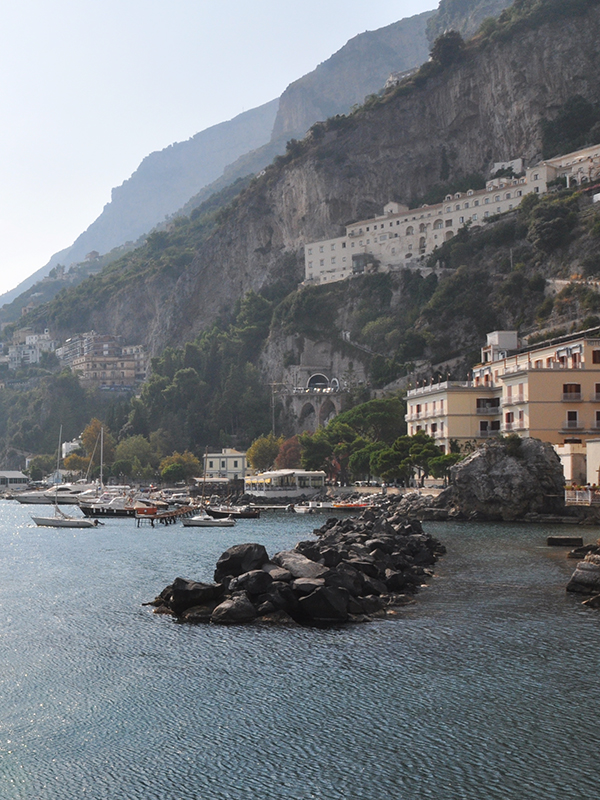


 , 25 km on southwest of Salerno
, 25 km on southwest of Salerno  , the provincial capital. A city with a long history, once the capital of one of Italy's four powerful maritime republics, beside Genoa,
, the provincial capital. A city with a long history, once the capital of one of Italy's four powerful maritime republics, beside Genoa,  and continue on the SS163; the same way (only from the opposite direction) you can go from Salerno (from where you can also take the SS18 and then the SS163). Coming from Naples, you can choose one of the two shorter roads (approx. 60 km), leaving the A3 motorway, exit Castellemare di Stabia
and continue on the SS163; the same way (only from the opposite direction) you can go from Salerno (from where you can also take the SS18 and then the SS163). Coming from Naples, you can choose one of the two shorter roads (approx. 60 km), leaving the A3 motorway, exit Castellemare di Stabia  (and continue via Furore
(and continue via Furore  ) or take exit Angri
) or take exit Angri  (followed by
(followed by  ) - however, these roads are less convenient
) - however, these roads are less convenient 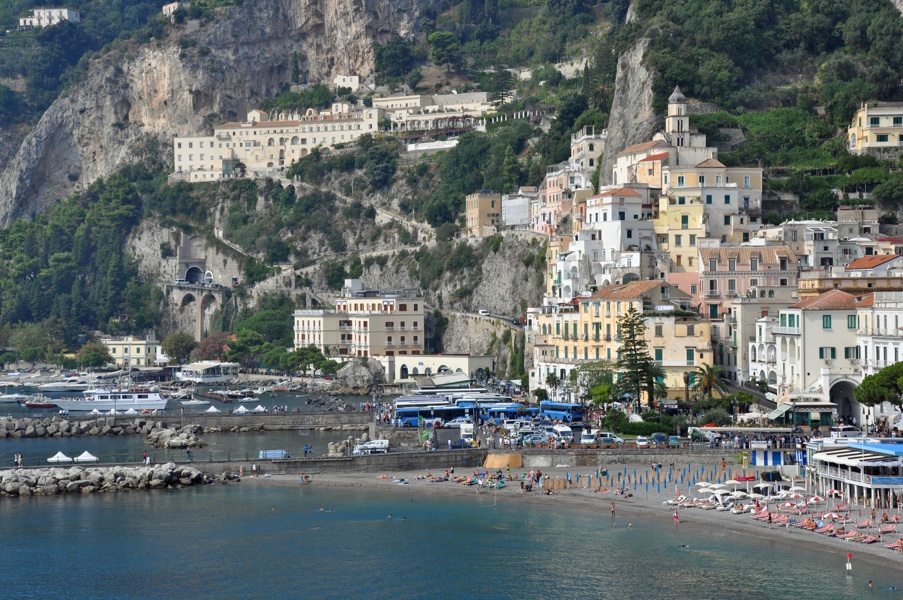
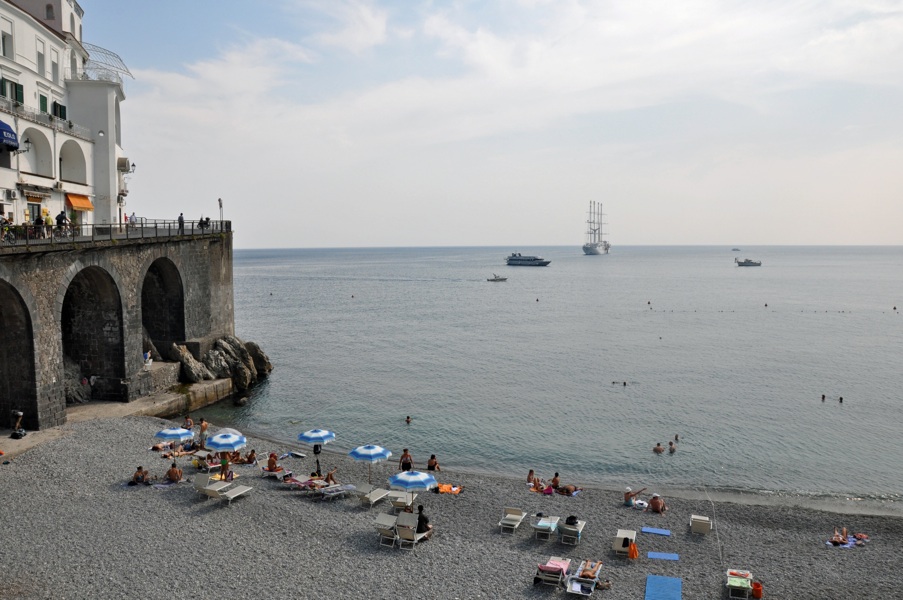

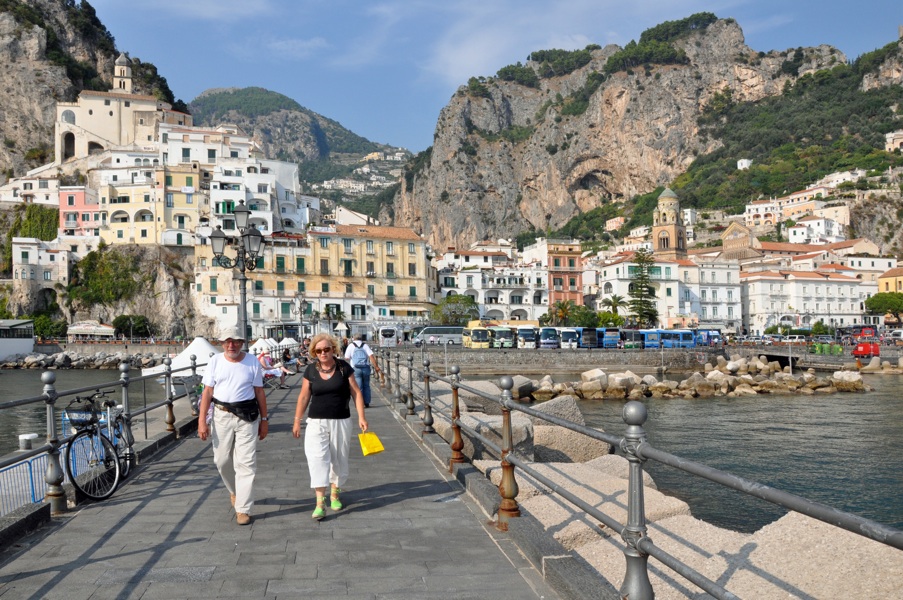
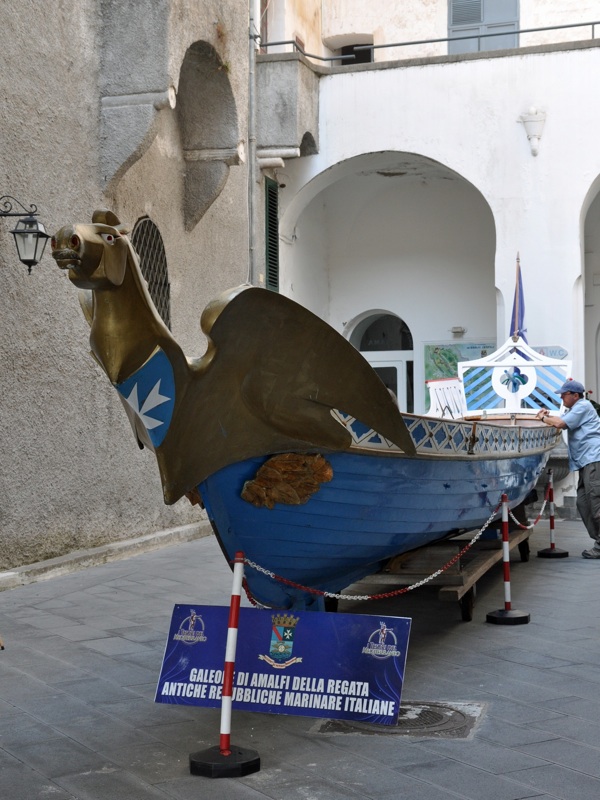
 (La cattedrale di Sant'Andrea, Duomo di Amalfi). The marker
(La cattedrale di Sant'Andrea, Duomo di Amalfi). The marker  stands for the main square of Amalfi, Piazza Flavio Gioia (named after the mythical Italian sailor and supposed inventor of the compass); east of the square is the main city beach, Spiaggia di Marina Grande
stands for the main square of Amalfi, Piazza Flavio Gioia (named after the mythical Italian sailor and supposed inventor of the compass); east of the square is the main city beach, Spiaggia di Marina Grande  , west - the harbor
, west - the harbor  .
.  refers to an interesting museum, known under different names (Museo Arsenale Amalfi, Museo dell'Arsenale, della Bussola e del Ducato Marinaro, etc.), gathering in the rooms where Amalfi warships were once built, renovated and stored, exhibits related to the history of Amalfi as a "maritime republic".
refers to an interesting museum, known under different names (Museo Arsenale Amalfi, Museo dell'Arsenale, della Bussola e del Ducato Marinaro, etc.), gathering in the rooms where Amalfi warships were once built, renovated and stored, exhibits related to the history of Amalfi as a "maritime republic".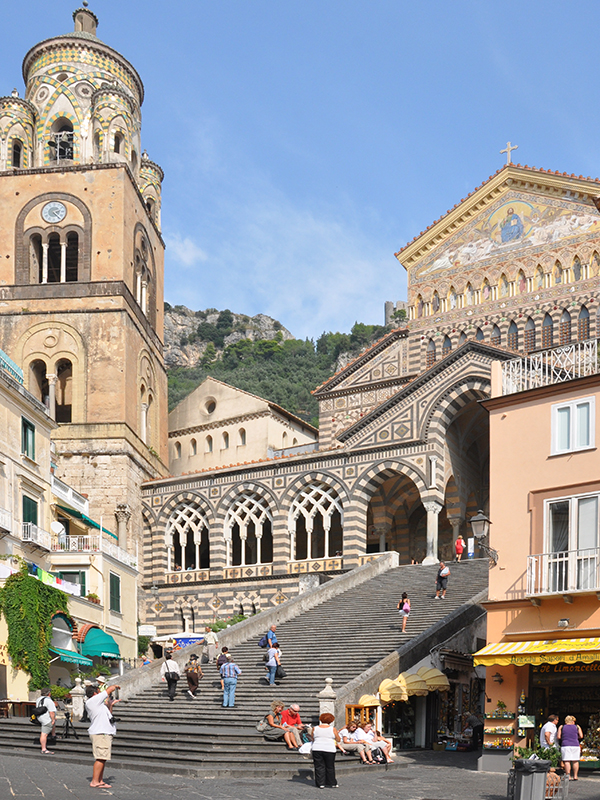
 , which is actually the place where Via Duca Mansone I turns into the main shopping street of Amalfi, Via Lorenzo d'Amalfi, which runs northwards from here
, which is actually the place where Via Duca Mansone I turns into the main shopping street of Amalfi, Via Lorenzo d'Amalfi, which runs northwards from here  . From here a wide staircase leads east to the cathedral vestibule.
. From here a wide staircase leads east to the cathedral vestibule.  - a sea cave known as Grotta dello Smeraldo
- a sea cave known as Grotta dello Smeraldo  , so called because of the peculiar colors of its interior and advertised by local travel agencies and local private guides as an attraction comparable to the famous Grotta Azzurra on the island of Capri. The grotto (45 mx 32 m and 24 m high) is partially filled with seawater, but has no connection to the open sea above sea level (with a lift). You can get to the nearby grotto from Amalfi via the SS163 road or by boat
, so called because of the peculiar colors of its interior and advertised by local travel agencies and local private guides as an attraction comparable to the famous Grotta Azzurra on the island of Capri. The grotto (45 mx 32 m and 24 m high) is partially filled with seawater, but has no connection to the open sea above sea level (with a lift). You can get to the nearby grotto from Amalfi via the SS163 road or by boat  ), and that today also is produced by hand in Amalfi special high quality paper called bambagina, exported to many European countries and used as decorative paper (eg for wedding invitations, business cards, etc.), as well as by artists.
), and that today also is produced by hand in Amalfi special high quality paper called bambagina, exported to many European countries and used as decorative paper (eg for wedding invitations, business cards, etc.), as well as by artists.


